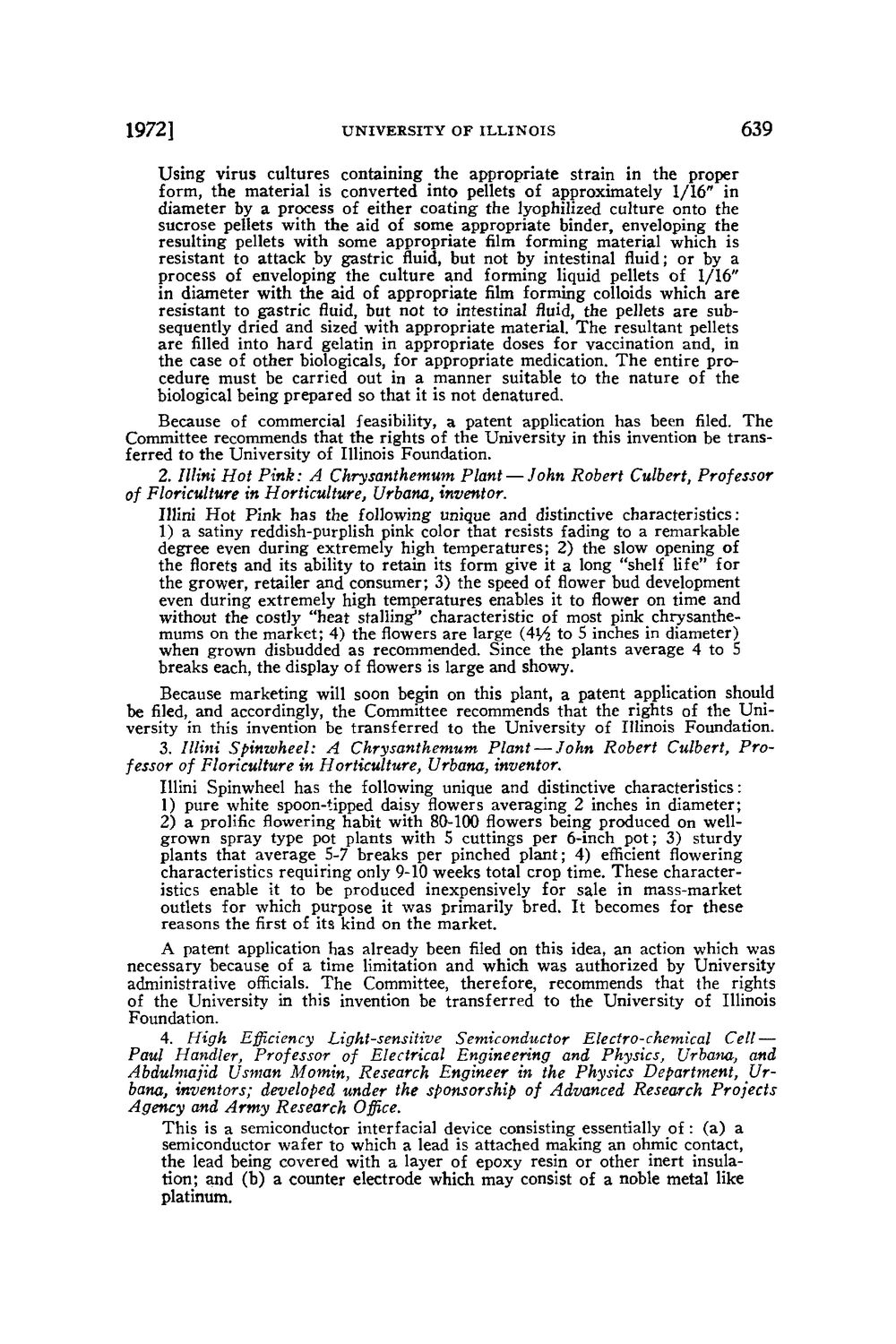| |
| |
Caption: Board of Trustees Minutes - 1972
This is a reduced-resolution page image for fast online browsing.

EXTRACTED TEXT FROM PAGE:
1972] UNIVERSITY OF ILLINOIS 639 Using virus cultures containing the appropriate strain in the proper form, the material is converted into pellets of approximately 1/16" in diameter by a process of either coating the lyophilized culture onto the sucrose pellets with the aid of some appropriate binder, enveloping the resulting pellets with some appropriate film forming material which is resistant to attack by gastric fluid, but not by intestinal fluid; or by a process of enveloping the culture and forming liquid pellets of 1/16" in diameter with the aid of appropriate film forming colloids which are resistant to gastric fluid, but not to intestinal fluid, the pellets are subsequently dried and sized with appropriate material. T h e resultant pellets are filled into hard gelatin in appropriate doses for vaccination and, in the case of other biologicals, for appropriate medication. T h e entire procedure must be carried out in a manner suitable to the nature of the biological being prepared so that it is not denatured. Because of commercial feasibility, a patent application has been filed. The Committee recommends that the rights of the University in this invention be transferred to the University of Illinois Foundation. 2. Illini Hot Pink: A Chrysanthemum Plant — John Robert Culbert, Professor of Floriculture in Horticulture, Urbana, inventor. Illini Hot Pink has the following unique and distinctive characteristics : 1) a satiny reddish-purplish pink color that resists fading to a remarkable degree even during extremely high temperatures; 2) the slow opening of the florets and its ability to retain its form give it a long "shelf life" for the grower, retailer and consumer; 3) the speed of flower bud development even during extremely high temperatures enables it to flower on time and without the costly "heat stalling" characteristic of most pink chrysanthemums on the market; 4) the flowers are large (4V^ to S inches in diameter) when grown disbudded as recommended. Since the plants average 4 to S breaks each, the display of flowers is large and showy. Because marketing will soon begin on this plant, a patent application should be filed, and accordingly, the Committee recommends that the rights of the University in this invention be transferred to the University of Illinois Foundation. 3. Illini Spinwheel: A Chrysanthemum Plant — John Robert Culbert, Professor of Floriculture in Horticulture, Urbana, inventor. Illini Spinwheel has the following unique and distinctive characteristics: 1) pure white spoon-tipped daisy flowers averaging 2 inches in diameter; 2) a prolific flowering habit with 80-100 flowers being produced on wellgrown spray type pot plants with 5 cuttings per 6-inch p o t ; 3) sturdy plants that average 5-7 breaks per pinched plant; 4) efficient flowering characteristics requiring only 9-10 weeks total crop time. These characteristics enable it to be produced inexpensively for sale in mass-market outlets for which purpose it was primarily bred. It becomes for these reasons the first of its kind on the market. A patent application has already been filed on this idea, an action which was necessary because of a time limitation and which was authorized by University administrative officials. T h e Committee, therefore, recommends that the rights of the University in this invention be transferred to the University of Illinois Foundation. 4. High Efficiency Light-sensitive Semiconductor Electro-chemical Cell — Paul Handler, Professor of Electrical Engineering and Physics, Urbana, and Abdulmajid Usman Momin, Research Engineer in the Physics Department, Urbana, inventors; developed under the sponsorship of Advanced Research Projects Agency and Army Research Office. This is a semiconductor interfacial device consisting essentially of : (a) a semiconductor wafer to which a lead is attached making an ohmic contact, the lead being covered with a layer of epoxy resin or other inert insulation; and (b) a counter electrode which may consist of a noble metal like platinum.
| |